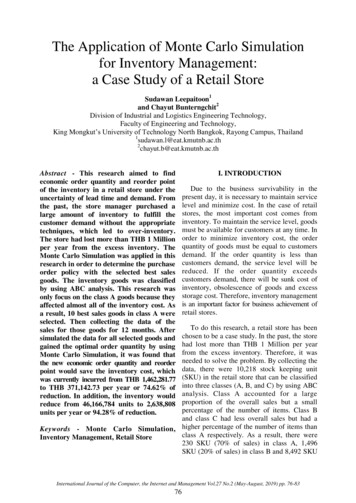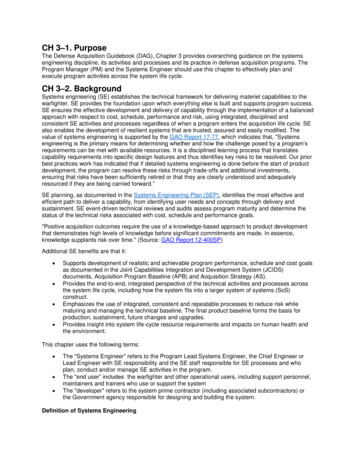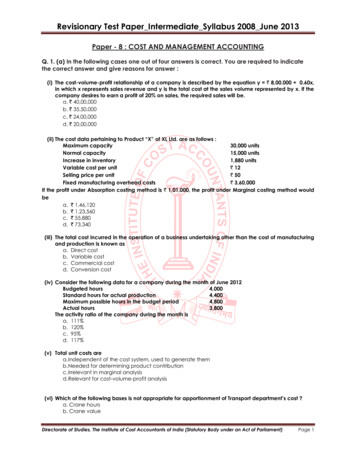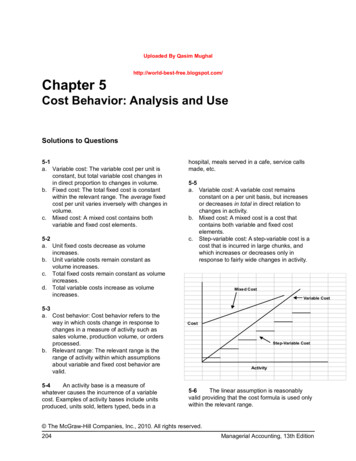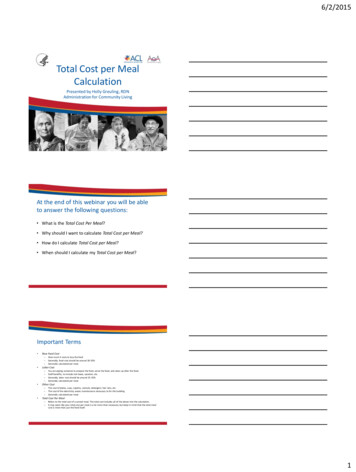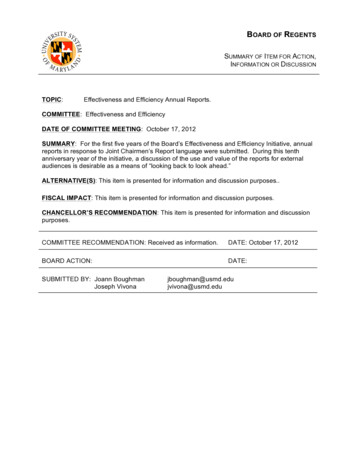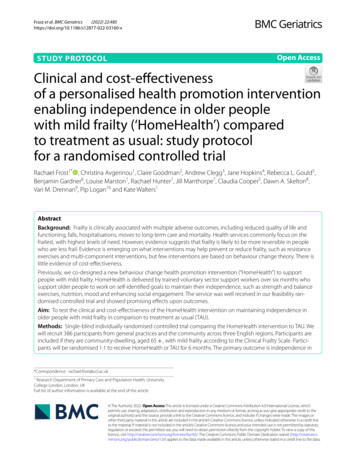
Transcription
(2022) 22:485Frost et al. BMC -xOpen AccessSTUDY PROTOCOLClinical and cost‑effectivenessof a personalised health promotion interventionenabling independence in older peoplewith mild frailty (‘HomeHealth’) comparedto treatment as usual: study protocolfor a randomised controlled trialRachael Frost1* , Christina Avgerinou1, Claire Goodman2, Andrew Clegg3, Jane Hopkins4, Rebecca L. Gould5,Benjamin Gardner6, Louise Marston1, Rachael Hunter1, Jill Manthorpe7, Claudia Cooper5, Dawn A. Skelton8,Vari M. Drennan9, Pip Logan10 and Kate Walters1AbstractBackground: Frailty is clinically associated with multiple adverse outcomes, including reduced quality of life andfunctioning, falls, hospitalisations, moves to long-term care and mortality. Health services commonly focus on thefrailest, with highest levels of need. However, evidence suggests that frailty is likely to be more reversible in peoplewho are less frail. Evidence is emerging on what interventions may help prevent or reduce frailty, such as resistanceexercises and multi-component interventions, but few interventions are based on behaviour change theory. There islittle evidence of cost-effectiveness.Previously, we co-designed a new behaviour change health promotion intervention (“HomeHealth”) to supportpeople with mild frailty. HomeHealth is delivered by trained voluntary sector support workers over six months whosupport older people to work on self-identified goals to maintain their independence, such as strength and balanceexercises, nutrition, mood and enhancing social engagement. The service was well received in our feasibility randomised controlled trial and showed promising effects upon outcomes.Aim: To test the clinical and cost-effectiveness of the HomeHealth intervention on maintaining independence inolder people with mild frailty in comparison to treatment as usual (TAU).Methods: Single-blind individually randomised controlled trial comparing the HomeHealth intervention to TAU. Wewill recruit 386 participants from general practices and the community across three English regions. Participants areincluded if they are community-dwelling, aged 65 , with mild frailty according to the Clinical Frailty Scale. Participants will be randomised 1:1 to receive HomeHealth or TAU for 6 months. The primary outcome is independence in*Correspondence: rachael.frost@ucl.ac.uk1Research Department of Primary Care and Population Health, UniversityCollege London, London, UKFull list of author information is available at the end of the article The Author(s) 2022. Open Access This article is licensed under a Creative Commons Attribution 4.0 International License, whichpermits use, sharing, adaptation, distribution and reproduction in any medium or format, as long as you give appropriate credit to theoriginal author(s) and the source, provide a link to the Creative Commons licence, and indicate if changes were made. The images orother third party material in this article are included in the article’s Creative Commons licence, unless indicated otherwise in a credit lineto the material. If material is not included in the article’s Creative Commons licence and your intended use is not permitted by statutoryregulation or exceeds the permitted use, you will need to obtain permission directly from the copyright holder. To view a copy of thislicence, visit http:// creat iveco mmons. org/ licen ses/ by/4. 0/. The Creative Commons Public Domain Dedication waiver (http:// creat iveco mmons. org/ publi cdoma in/ zero/1. 0/) applies to the data made available in this article, unless otherwise stated in a credit line to the data.
Frost et al. BMC Geriatrics(2022) 22:485Page 2 of 13activities of daily living (modified Barthel Index) at 12 months. Secondary outcomes include instrumental activities ofdaily living, quality of life, frailty, wellbeing, psychological distress, loneliness, cognition, capability, falls, carer burden,service use, costs and mortality. Outcomes will be analysed using linear mixed models, controlling for baseline Barthelscore and site. A health economic analysis and embedded mixed-methods process evaluation will be conducted.Discussion: This trial will provide definitive evidence on the effectiveness and cost-effectiveness of a home-based,individualised intervention to maintain independence in older people with mild frailty in comparison to TAU, thatcould be implemented at scale if effective.Trial registration: ISRCTN, ISRCT N5426 8283. Registered 06/04/2020.Keywords: (3-10) frailty, RCT , Primary care, Ageing, Prevention, Community-dwelling, Behavioural changeBackgroundFrailty is clinically defined as an accumulation of multipledeficits and a reduction in physiological reserves occurring across multiple body systems as we age, leading topoor recovery from even minor events, such as a urinarytract infection or non-injurious fall [1]. Frailty occurs inapproximately 12% of people aged 65 years worldwide[2] and 14% of older people in England [3]. It is associated with an increased risk of falls, disability, hospitalisation, moves to a care home, dementia, poor quality oflife and death [4–7]. Healthcare costs are consistentlyestimated to be higher in frail older people comparedto non-frail older people, largely as a result of increasedinpatient costs [8–10]. However, frailty can be understood as a continuum and reversal is possible [11].Exercise programmes, particularly resistance exerciseand in combination with nutrition interventions, canreduce frailty in primary care settings [12]. Current international clinical practice recommendations for frailtysupport the use of a range of interventions, including:physical activity programmes based on resistance training; social support; development of comprehensive careplans addressing polypharmacy, sarcopenia, treatablecauses of weight loss and fatigue; and protein or caloricsupplementation if the person has lost weight or has evidence of malnutrition [13]. Pharmacological treatments,vitamin D (unless the person is deficient), psychologicaltherapies or hormone therapy are not currently recommended to treat frailty [13].Frailty is most commonly conceptualised using theFried phenotype [14] or Rockwood scale [15]. The Friedcriteria groups people experiencing more than three offive possible frailty components as ‘frail’, and those withone or two components as ‘pre-frail’ [14]. Pre-frailty is arisk-state which predisposes an individual to developingfrailty [16]. The Rockwood scale classifies people fromrobust to severely frail, using either cumulative deficits orclinical observation [15]. There is a wide range of differences in functioning across the spectrum of frailty, andlittle guidance on where to target interventions, althougha meta-analysis of 16 studies suggested that over anaverage of 3.9 years, those who are frail (using the Friedphenotype) are less likely to transition back to robustnessthan those who are less frail [11]. This suggests targetingearlier stages of frailty is likely to be a more successfulapproach to preventing decline.Mild frailty is an intermediate stage on the RockwoodClinical Frailty Scale where older people experience someloss of physiological reserves but can recover after astressor event, typically feeling “slowed up”, and requiringgreater assistance in instrumental activities of daily living, e.g. cooking, shopping and money management [15].Around 13% of older people can be classed as ‘mildlyfrail’ [15]. Mild frailty is associated with adverse outcomes, including a higher risk of death and moving into acare home [15], increased need for care at discharge fromhospital [17] and poorer outcomes after post-surgicaldischarge [18]. Few interventional studies have targeteda mildly frail population with the aim of maintainingindependence.There is little focus in clinical guidelines on frailty prevention, apart from a brief reference to the use of exercise in pre-frailty to prevent frailty [13]. Few UK policiesare directed ‘upstream’ to those who are less frail [12],although England’s NHS Long-Term Plan [19] clearlyemphasises prevention and ‘supporting people to agewell’, including proactively identifying those who wouldbenefit from targeted support to maintain independence.Most studies on frailty prevention (generally targetingthose who are pre-frail) have focussed on single or dualintervention domains, typically exercise plus or minusnutrition [20, 21]. Multi-domain interventions including exercise and a range of other domains such as social,nutritional, cognitive training, or medication reviewshow greater promise at reducing or preventing frailtyand its related domains across a number of trials [22–25].However, there is a lack of clarity on which strategiesneed to be adopted within interventions to maximiseeffectiveness, as well as absence of a clear theoreticalbasis, rigorous development process or stakeholder inputin intervention development [26]. This can provide challenges when optimising or implementing interventions.
Frost et al. BMC Geriatrics(2022) 22:485Very limited evidence suggests group-based exerciseinterventions may be more effective than individual sessions, however this may not be feasible to deliver to thosewho are finding leaving their home more challenging,and there is currently little guidance as to the optimal frequency, intensity, time and type of exercise interventionsfor frailty management or prevention [13]. More holistic approaches, such as comprehensive geriatric assessment with follow-up visits or preventative home visits,are promising [27, 28] but typically resource-intensive,requiring nurses or a multidisciplinary team, and so present challenges to delivery at scale. The limited numberof cost-effectiveness studies available at present showedmixed results. Multidisciplinary team meetings withproactive care management across multiple domainstargeted at frail older people, such as The CareWell programme or the Welcheren Integrated Care model, havenot shown cost-effectiveness compared to usual primarycare [29, 30]. However a resistance training and nutritioneducation intervention for pre-frail and frail older people with diabetes produced cost savings and increasedQALYs [31], whilst a cognitive behavioural interventionto reduce concerns about falls in frail older people wasfound to be cost-effective [32].In response to these gaps in the evidence, in an earlierstudy we developed and feasibility tested an intervention to support independence in older people with mildfrailty [33], following Medical Research Council guidelines [34]. The HomeHealth service is a complex theory- and evidence-based behaviour change intervention,arising from an asset-based approach [35], Baltes’ modelof ageing [36] and behaviour change theory [37]. Assetbased approaches aim to maximise positive capabilityand maintain health promoting factors to enhance selfefficacy, problem-solving and coping, in order to retainreserves and functioning [35]. This contrasts to the morecommonly used deficit-based approach, which focuseson individuals’ problems and what they lack. Baltes’model of ageing suggests that successful ageing occurswhen an older person prioritises realistic goals or activities that they want to maintain (selection), optimises howthese can be performed (optimisation) and adjusts forlimitations (compensation) [36]. The behaviour changetheory component is based upon the COM-B model,which states that for any behaviour to take place, theperson must have sufficient physical and psychologicalcapability, social and physical opportunity and consciousor innate motivation [37]. COM-B provides a frameworkto link these factors to the specific techniques needed toenable changes in behaviour.The HomeHealth service is a home-based intervention that we developed based on a series of evidencereviews regarding intervention content and behaviourPage 3 of 13change techniques used in health promotion interventions for older people [26, 33, 38] and qualitativeresearch with older people with mild frailty, carers andhealthcare professionals [39]. It was then co-designedwith a range of stakeholders, including older people,healthcare professionals, researchers and voluntarysector representatives [33].The HomeHealth service was tested in a feasibility randomised controlled trial (RCT) compared to treatmentas usual (TAU, usual GP care), in which we recruited51 older people with mild frailty from four UK generalpractices, 26 of whom received the intervention. Thestudy successfully recruited within the expected timeframe, with 96% participants remaining in the study at6 months and minimal missing data ( 1%) [33]. Our process evaluation indicated that the intervention was wellreceived according to participant interviews and a survey[40], feasible to deliver and had 91% attendance ratesfor appointments. The service was delivered at modest cost ( 307—equivalent 417/patient in Feb 2022). At6 months we found significantly better functioning (Barthel Index; 1.68, p 0.004) and grip strength ( 6.48 kg,p 0.02), reduced psychological distress (GHQ-12; -3.92,p 0.01) and increased capability-adjusted life years( 0.017, p 0.03) in the intervention arm compared totreatment as usual. There were no differences in otheroutcomes. Given the promising nature of the intervention, we aim to test the effectiveness and cost-effectiveness of HomeHealth in a definitive trial across a widerrange of participants, providers and contexts.AimsThis trial aims to:1. Test the clinical effectiveness of HomeHealth inmaintaining independence in a RCT in comparisonto TAU.2. Determine the cost-effectiveness of HomeHealth incomparison to TAU.3. Quantify the costs and savings of HomeHealth to different health and social care providers.4. Explore the context, mechanisms and impact of theintervention for different populations (age, gender,deprivation, ethnicity, rurality) and barriers and facilitators to implementation at scale.MethodsWe will carry out a two-arm, single-blind, parallelgroup RCT comparing HomeHealth to TAU, includinga cost-effectiveness analysis and mixed methods processevaluation.
Frost et al. BMC Geriatrics(2022) 22:485Eligibility criteriaWe will include community-dwelling older people(including those in sheltered or extra care housing – nocare workers on site) aged 65 who are registered with ageneral practice in the participating site area; scoring as‘mildly frail’ on the Clinical Frailty Scale (CFS score of 5),which is defined as ‘more evident slowing, who need helpor support in higher order instrumental activities of dailyliving (e.g. finances, heavy housework), with progressiveimpairment of outdoor mobility, shopping and housework’ [15]; life expectancy of 6 months; and capacity toconsent to participate.We will exclude care home residents; people with moderate-severe frailty (CFS score of 6–9) or not frail (CFSscore of 1–4); receiving palliative care; or already casemanaged (e.g. receiving a similar ongoing interventionfrom the voluntary sector or a community matron).InterventionA detailed breakdown of the HomeHealth service isprovided according to the TIDIER checklist [41] in supplementary file 1. HomeHealth is delivered over approximately six appointments in the older person’s home.Three appointments is considered a minimum dose,whilst participants could receive up to a maximum of 12if they have particularly complex needs. These were originally planned to be delivered face-to-face with some telephone interim support, however they were adapted to bedelivered by phone or video call, as needed, in light of theCovid-19 pandemic. If needed, internet-enabled tabletscan be offered to participants receiving the interventionremotely to facilitate communication.HomeHealth follows an intervention manual. In thefirst appointment, a HomeHealth worker comprehensively assesses the person, with a particular focus onsocialising, mobility, nutrition and psychological wellbeing (including mood and memory), but including anyother relevant issues (e.g. pain, continence, caring). Participants are encouraged to identify an outcome goal forthe service that is important for them, and at either thefirst or second appointment are encouraged to break thisdown into behavioural goals, which are then operationalised into SMART (specific, measurable, achievable,relevant, timely) goals that are achievable in small stepsover the course of the intervention. Goals can include arange of activities, such as home-based exercises basedon the Otago programme (which shows effectiveness atreducing falls [42] and improving balance [43]), identifying social activities to attend or making dietary changesto improve protein or calorie intake. The COM-B model[37] is used by the HomeHealth worker to assess capability, opportunity and motivation to achieve the behavioural goal and to identify any barriers, developing anPage 4 of 13action plan with the person as to how these might beovercome. These are documented on a Health and Wellbeing Plan, and self-monitoring forms (e.g. diaries) maybe used to record completion of activities such as exercises. Where relevant, equipment (e.g. weights or resistance bands) or information resources (e.g. details of localsocial groups) is provided to the older person.At each subsequent appointment, progress towardsachieving goals is reviewed, with changes made asneeded to resolve any issues or to extend goals (e.g.increasing repetitions or resistance in strength exercises).An emphasis is placed on how new behaviours could bemaintained over time, and habit formation. Further goalsmay be identified over following sessions. There are norestrictions on accessing other services or treatmentsduring the study period.HomeHealth is delivered by trained HomeHealthworkers, who are not required to have a specific healthor social care qualification but to have some experiencein working with older people (for example, in the voluntary or not for profit sector). HomeHealth workersare based in local voluntary sector services in each areaand are supervised by a centrally located Team Leader,in biweekly remote group supervisions with one-to-onesupport as needed. HomeHealth training is deliveredentirely remotely as a blend of live and asynchronouscontent delivered by specialists in that area, includingpre-recorded webinars and live seminars, activities and astrong emphasis on case-based discussions. The trainingtime is intended to be equivalent to a one-week course.HomeHealth workers also have access to remote supportfrom the expert course providers (in behaviour change,exercise for older people, nutrition and psychologicalwellbeing) via email for specific queries on tailoring theintervention for individual clients.The control arm will receive TAU. This is defined asstandard care that any eligible patient aged 65 wouldnormally receive in England in primary care (e.g. contactwith the GP or the practice nurse), including any othercommunity or secondary care input as a result of referral by a GP. No mild frailty-specific interventions are currently widely available in the UK.Setting and recruitmentParticipants will be recruited from general practices inEngland, in one of three areas (North Thames Region,East & North Hertfordshire and West Yorkshire). Practices will be asked to undertake list searches to identifythose fitting the eligibility criteria above, using the frailtytool available to the practice (usually the ElectronicFrailty Index) [44], which will then be screened by clinicians to remove known ineligible patients. Practices willthen send invitation letters, study leaflets and reply slips
Frost et al. BMC Geriatrics(2022) 22:485to potentially eligible patients. Potential participantscan also be referred to the study directly by clinicians inparticipating General Practices or local voluntary sectorstaff. We will undertake community-based recruitmentsuch as presenting to local groups and providing leafletsto relevant community organisations, targeting underserved populations to maximise diversity of our sample.Researchers will telephone screen potential participants according to the inclusion criteria, and if eligible,will post an information sheet and invite them to anappointment (face-to-face or remote) to seek consent andundertake a baseline assessment. An interpretation service is available if required. After completion of a baselineassessment and confirmation of eligibility, participantswill be randomised.RandomisationWe will randomise participants 1:1 (stratified by site)to receive the HomeHealth service or TAU. Randomisation will be carried out by unblinded staff membersusing the remote computerised web-based application‘Sealed Envelope’, provided by UCL’s Priment ClinicalTrials Unit. Outcome assessors, the Chief Investigator,the Trial Manager and Trial Management Group members who are not site Principal Investigators or responsible for intervention delivery will be blinded to participantallocation.OutcomesClinical outcomes will be measured at baseline, 6 monthsand 12 months by a researcher blind to interventionstatus (see Table 1). Maintenance of blinding will bedocumented using a Researcher Perception form. Assessments will be completed face-to-face at the participant’shome or remotely (by video or telephone), according toany government guidelines for prevention of Covid-19infection and the participant’s preferences. Assessmentscan be divided into two sessions if needed. Participantsreceive a 10 voucher (max 3) for completing each assessment. Data will be kept confidentially at sites and enteredin a secure web-based database developed for the trial. Amonitoring plan is in place to ensure data quality.The primary outcome is the Modified Barthel Index(BI) [45] measured at 12 months, which is intervieweradministered with scoring based on discussions withparticipants. The BI measures an individual’s ability toundertake basic Activities of Daily Living (ADLs) and iswidely used, correlates well with need for home care [64]and is considered a key outcome measure in frailty trials [65]. It measures what people actually do as opposedto what they could do. Our intervention arm showedsignificantly higher scores than usual care in our feasibility RCT at 6 months [33]. Our secondary outcomesPage 5 of 13and variables collected at each timepoint are reported inTable 1.The study was planned before Covid-19 (winter2019) and we intended to conduct face-to-face researchassessments, measuring frailty using handgrip strength(dynamometer), gait speed (time taken to walk a measured distance) and weight loss (measured using scales).Given the restrictions associated with the pandemic thatwere implemented in March 2020, we revised our protocol to use self-report measures (validated in older people across a range of frailty levels [47]) to enable remoteassessments. When research assessments are conductedface-to-face, we will additionally carry out physical gaitspeed assessment (m/s) [66] and grip strength assessment using a dynamometer (kg, highest score out ofthree trials) [67] to confirm the validity of the self-reportmeasures in our population with mild frailty.SafetyResearchers will collect Adverse Events (AEs) and Serious Adverse Events (SAEs) at 6-and 12-month timepoints, and participants will be encouraged to reportany AEs or SAEs experienced between assessments bycontacting researchers. HomeHealth workers (HHWs)will also report adverse events. All AEs and SAEs will bereviewed by a site Principal Investigator and/or ClinicalSafety Lead (CSL), and all SAEs will be reviewed by theChief Investigator. Only SAEs related to the interventionwill be reported to the Sponsor. Researchers will not haveaccess to relatedness assessments in order to maintainblinding. Relatedness to the intervention will be assessedby the site Principal Investigator and/or CSL in a blindedmanner for AEs and SAEs reported by researchers, andunblinded for AEs and SAEs reported by HHWs. Thereporting of SAEs will be monitored by Priment CTU.Pharmacovigilance standard operating procedures will befollowed.Health economic evaluationHealthcare resource use (contacts with primary, community and secondary care, hospitalisations, procedures and medications) will be extracted from patientmedical records. Service resource use not availablefrom files and wider services (e.g. of voluntary sector and social care) will be collected using a modifiedClient Services Receipt Inventory (CSRI) [63] at 0, 6and 12 months, asking about the previous 6-months.The CSRI has been modified based on the populationin our feasibility study to include the range of servicesthey may use (e.g. podiatry, opticians, hearing aids,dental care, physiotherapy, exercise classes, day care,etc.). Health and social care resource use will be costedusing nationally published sources (PSSRU [68], NHS
Frost et al. BMC Geriatrics(2022) 22:485Page 6 of 13Table 1 List of data collected and timepointsConstructMeasure used (supporting references)Baseline 6 months 12 months Anytime Extractedfrom medicalnotesIndependence in ADLsModified Barthel Index [45]Instrumental ADLsNottingham Extended Activities of DailyLiving [46] FrailtyFried Frailty Phenotype score [14]a.Gait speedSelf-reported according to Op het Vald’s(2018) questionnaire [47]b. Grip strengthSelf-reported according to Op het Vald’s(2018) questionnaire [47]c. Physical activityd. Exhaustione. Weight loss International Physical Activity Question naire-Elderly [48], quantified according tothe E guidelines [49] Weight loss question from the Mini-Nutri- tional Assessment Short Form [50] Exhaustion questions from 7-item Centrefor Epidemiological Studies DepressionScale “7. I felt that everything I did was aneffort,” “20. I could not get going.” [14] Quality of life and Quality-adjusted LifeYearsEuroQol-5D-5L [51]Capability and Capability-adjusted LifeYearsICEpop CAPability measure for Olderpeople (ICECAP-O) [52]WellbeingWarwick-Edinburgh Mental WellbeingScale (WEMWBS) [53]Psychological distressGeneral Health Questionnaire-12 [54]LonelinessUniversity of California, Los Angeles3-item loneliness scale [55]CognitionMontreal Cognitive Assessment (MoCA)[56] or telephone MoCA (remote itemsonly) [57, 58]FallsProFANE consensus definition [59]MortalityMedical notes or family reportCarer burdenAdapted from adapted iMTA Valuation ofInformal Care Questionnaire [60]DemographicsQuestionnaire developed for trialAlcohol intakeAlcohol Use Disorders Identification Test– consumption (AUDIT-C [61])Deprivation levelLocal area Index of Multiple Deprivationbased on postcode [62]Smoking statusSingle questionCovid-19 statusQuestions on infection status and ongoing symptomsUnpaid care and use of primary and com- Modified Client Services Receipt Invenmunity health and social care servicestory [63]Use of health services, medications andnumber of long-term conditionsAdverse eventsReference Costs [69] and the British National Formulary [70]). We will additionally ask about unpaid andpaid (state and out-of-pocket) carer time for specificactivities of daily living, using an adapted iMTA Valuation of Informal Care Questionnaire (iVICQ) [60]. This will be costed as the cost of face-to-face local authority-funded homecare worker time to reflect the factthat if this care were to be reduced homecare workerswould be the alternative to unpaid carers providing thisassistance.
Frost et al. BMC Geriatrics(2022) 22:485Intervention costs (including staff training, administration, supervision and delivery) will be included in thecosts of the intervention group.Process evaluationThe process evaluation will collect quantitative and qualitative data alongside the main trial. Feedback on servicedelivery (e.g. fidelity) will not be given to service providers or other team members until after trial completion.An independent researcher will carry out up to 40 semistructured audio-recorded interviews with participantsreceiving the service, service providers and other stakeholders, using topic guides developed with our public andpatient involvement and engagement (PPIE) representatives and stakeholders from our implementation group.We will additionally explore the impact of remotely delivering the service in the time of Covid-19 and its influenceupon participant and provider experiences.HomeHealth workers will keep an ongoing recordof service delivery process data, including number ofappointments attended, modality, technical issues experienced if delivering remotely, duration and reasons fornon-attendance. Goals will also be recorded, and willbe coded into mobility, psychological, social, memory,nutrition or other. We will ask providers to rate progresstowards achieving goals, including 0–2 ratings for eachSMART goal (0 no progress, 1 partially met/some progress, 2 met/exceeded goal) and goal attainment scalingfor outcome goals (from -2 (much less than expected progress) to 2 (much more than expected progress) [71]).Fidelity will be assessed through fidelity checklists, developed for this intervention and based on what should beincluded at each appointment. These will be completedafter each appointment by HomeHealth workers. We willrecord all audio appointments, and independently verifyfidelity using the same checklist by a trained rater, whowill check recordings for all appointments from 10% individuals receiving the intervention.We will also utilise trial data to explore mechanisms ofimpact, including demographic data to assess reach andoutcome data to assess whether setting goals on one topicwill affect the hypothesised linked outcome (e.g. psychological goal and psychological distress scores).Sample sizeWe are aiming to recruit a sample size of 386 people (193per arm). This will provide 90% power at the 5% significance level to detect a minimum clinically importantdifference of 1.85-points [72] in the BI, with a standarddev
therapies or hormone therapy are not currently recom-mended to treat frailty [13]. Frailty is most commonly conceptualised using the Fried phenotype [14] or Rockwood scale [15]. e Fried criteria groups people experiencing more than three of ve possible frailty components as 'frail', and those with one or two components as 'pre-frail' [14].


